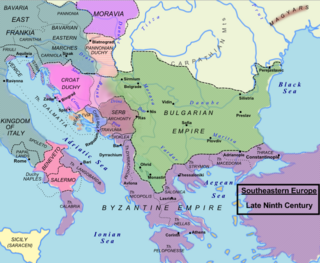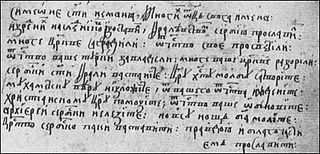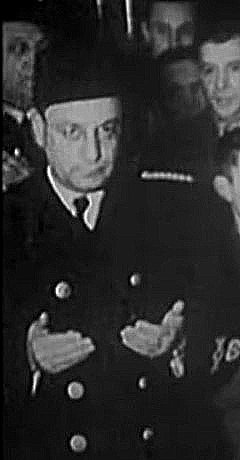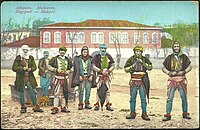
Duklja was a medieval South Slavic state which roughly encompassed the territories of modern-day southeastern Montenegro, from the Bay of Kotor in the west to the Bojana River in the east, and to the sources of the Zeta and Morača rivers in the north. First mentioned in 10th– and 11th century Byzantine chronicles, it was a vassal of the Bulgarian Empire between 997 and 1018, and then of the Byzantine Empire until it became independent in 1040 under Stefan Vojislav who rose up and managed to take over territories of the earlier Serbian Principality, founding the Vojislavljević dynasty. Between 1043 and 1080, under Mihailo Vojislavljević, and his son, Constantine Bodin, Duklja saw its apogee. Mihailo was given the nominal title King of Slavs by the Pope after having left the Byzantine camp and supported an uprising in the Balkans, in which his son Bodin played a central part. Having incorporated the Serbian hinterland and installed vassal rulers there, this maritime principality emerged as the most powerful Serb polity, seen in the titles used by its rulers. However, its rise was short-lived, as Bodin was defeated by the Byzantines and imprisoned; pushed to the background, his relative and vassal Vukan became independent in Raška, which continued the fight against the Byzantines while Duklja was struck with civil wars. Between 1113 and 1149 Duklja was the centre of Serbian–Byzantine conflict, with members of the Vojislavljević as protégés of either fighting each other for power. Duklja was then incorporated as a crown land of the Grand Principality of Serbia ruled by the Vukanović dynasty, subsequently known as Zeta, remaining so until the fall of the Serbian Empire in the 14th century.
Isa-Beg Ishaković was an Ottoman Bosnian general and the governor of the Sanjak of Bosnia for most of his career. Of Bosnian noble origin, he was recruited after being held hostage by the Ottomans. He was a provincial governor during the 1450s and 1460s, first in charge of the Sanjak of Skopje, and then the Sanjak of Bosnia. He was instrumental in the Ottoman conquests in the region, and was one of the Sultan's most trusted generals.
Ante Prkačin is a Croatian and Bosnian general, businessman and right-wing politician.

Kanalites were a medieval Slavic tribe settled in the today's region of Konavle, within Dalmatia, Croatia, mentioned in the chapter titled "Of the Terbounians and Kanalites and of the country they now dwell in" of the 10th century De Administrando Imperio by Byzantine Emperor Constantine VII.
Trostruki surduk is the name of a place in Belgrade, Serbia, between Bežanija and Surčin, where the mass murder of 240–450 Jews during World War II was organized. The exact number of murdered people, date of execution and the concentration camp that they were brought from remains unknown.
Rasnica is a village in the municipality of Pirot, Serbia. According to the 2002 census, the village has a population of 391 people.

The Cetinje Chronicle is a collection of manuscripts compiled by Vasilije Petrović who added some of his own writings to it. It contains 81 leaves of dimensions 32 cm x 21,5 cm. It is kept in Cetinje monastery. There are other versions of this collection which are not identical to the original because the original texts were transcribed by different people at different times. The first scholar who used this chronicle as source for his works was Vasilije Petrović who used it for his work on history of Montenegro, published in Moscow in 1754.

The Reževići Monastery is a medieval Serbian Orthodox monastery located in Katun Reževići village between Budva and Petrovac in modern-day Montenegro. The monastery has two churches. According to a local legend, the 'Church of the Dormition of the Mother of God' was built in the 1220s by Stefan Nemanjić, the first king of Serbia while the 'Church of the Archdeacon Stefan' was built by Stephen Uroš IV Dušan of Serbia in 1351.
The Battle of Novšiće was a battle for control over Plav and Gusinje fought on 4 December 1879 between the forces of Principality of Montenegro led by Marko Miljanov and local pro-Ottoman forces which included irregulars of the League of Prizren, both commanded by Ali Pasha, the Kaymekam of Gusinje. The League of Prizren consisted mainly of Albanians and from Plav and Gusinje in Scutari Vilayet and irregulars from Kosovo Vilayet.

Mugoše was a historical tribe (pleme) and area in the Brda region of Montenegro. Mugoše were located around the region of Piperi. Toponyms related to them can be found in many parts of the region, such as Mugošina Livada in Komani.
Radonja Petrović, known as Vojvoda Radonja was the vojvoda (duke) of the Kuči tribe. Radonja's father Petar was a middle child of Vojvoda Iliko Lalev and held the title until his death when it was passed to his brother priest Mirčeta. Radonja, thus, succeeded his uncle Mirčeta as the duke of Kuči, being the great-great-grandson of Drekale, eponymous founder of Drekalovići. He came to be the leader of a group of tribes in what is today eastern Montenegro that, together with Habsburg Serbian troops, fought against the Ottomans, and was granted the title Guvernadur of all the Hills by Venetians, for whom he managed the postal traffic with the Ottomans.

Jakup Ferri was a notable Albanian fighter from Plav-Gusinje who served as a local leader in the League of Prizren's resistance during the Principality of Montenegro's attempt to subjugate his homeland in 1879. He was distinguished in the Battle of Novšiće, where he died.
The Serb Uprising of 1737–1739 broke out following Austria's defeats against the Ottomans, when the Austrian Emperor issued proclamations that the Christians in the Balkans rise against the Ottoman Empire. The Austrian Emperor called on the Serbs, who were ready to revolt, on 15 June 1737, and stressed that they would fight in an alliance with Russia against a common enemy. The Serbs organized themselves under Serbian Patriarch Arsenije IV. The uprising had a wide geographical extent, from Belgrade to eastern Bosnia and Herzegovina, Montenegro and the Šar Mountain. The Albanian Klimenti tribe also joined the uprising. The failed war prompted Serbs, mostly from Herzegovina, Sandžak, Metohija and Montenegro, to flee under the leadership of Arsenije IV from the Ottoman territories into the Habsburg monarchy.
Battle of Ulqin was a battle between the Ottoman forces of Dervish Pasha and Albanian irregulars in the year of 1880 at the region of Kodra e Kuqe, close to Klleeznes. The area of Ulcinj had been handed over to Montenegro by the Ottomans after the Albanians previously fought against the annexations of Hoti and Grude. The Great powers instead pressured the Ottomans to hand over the area of Ulcinj, but also here the Albanians refused. Eventually the Great powers forced the Ottomans to take actions against the League of Prizren, ending the resistance and successfully handing over the town of Ulcinj to Montenegro.

The Macure were an Albanian tribe that lived on the territory on the part of Montenegro which is today known as Šekular. Bratonožići and Rovci. Like other non-Slavic tribes of Montenegro, they were either assimilated or expelled. The majority of scholars consider them to have been of Albanian origin. Today, their name is preserved in local Serbian legends and myths, while their name is sometimes used in Montenegro as derogative.
The moving of the Serbian industry to western Yugoslav republics was a strategy of the government of the Socialist Federal Republic of Yugoslavia to conduct massive transfer of industrial plants, machinery, technology and experts from PR Serbia to the western republics of Yugoslavia during the Informbiro period (1948—52) and shortly after it. In some cases, only parts of industrial plants were moved while in others the whole factories were dismounted and transported out of Serbia. Since the ratio of highly educated people was very low at that time, moving experts out of Serbia had substantial negative consequences for its future development.
Selim Begu Mustafa or Selim-beg Mustafagić was an Albanian lord and bey of Bar in the 19th century. He was the son of Mustafa Aga, who derived from Durrës, and was one of the first to settle in Bar after the Ottoman conquest in 1571. Selim Begu Mustafa fought against the Montenegrins and ruled with the Bosnian-Albanian nobility against the Porte.

Alija Šuljak (1901–1992) was a prominent Bosnian Muslim Croat who was a professor, politician and military officer of Ustaše during World War II, best known as one of the main perpetrators of the genocide of Serbs in Eastern Herzegovina.
The May consultations were an underground gathering of the Central Committee (Politburo) of the Communist Party of Yugoslavia (CPY) and leaders of its regional branches held after World War II in Yugoslavia started, on the initiative of Josip Broz Tito in early May 1941 in Zagreb, at the time part of the so-called Independent State of Croatia.

The 2020 Zagreb shooting, commonly referred to as the St. Mark's Square attack, occurred on 12 October 2020 in Zagreb, Croatia, when 22-year-old Danijel Bezuk approached Banski dvori, which houses the office of the Prime Minister and serves as the meeting place of the government, on St. Mark's Square and started shooting at it with an assault rifle, wounding a police officer in the process. In the aftermath, the perpetrator ran off to a nearby neighborhood and committed suicide.








